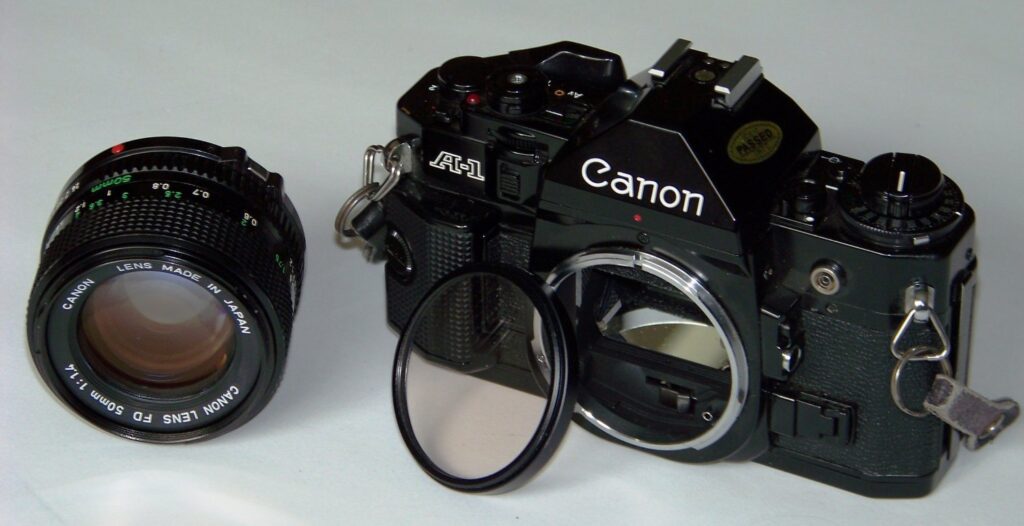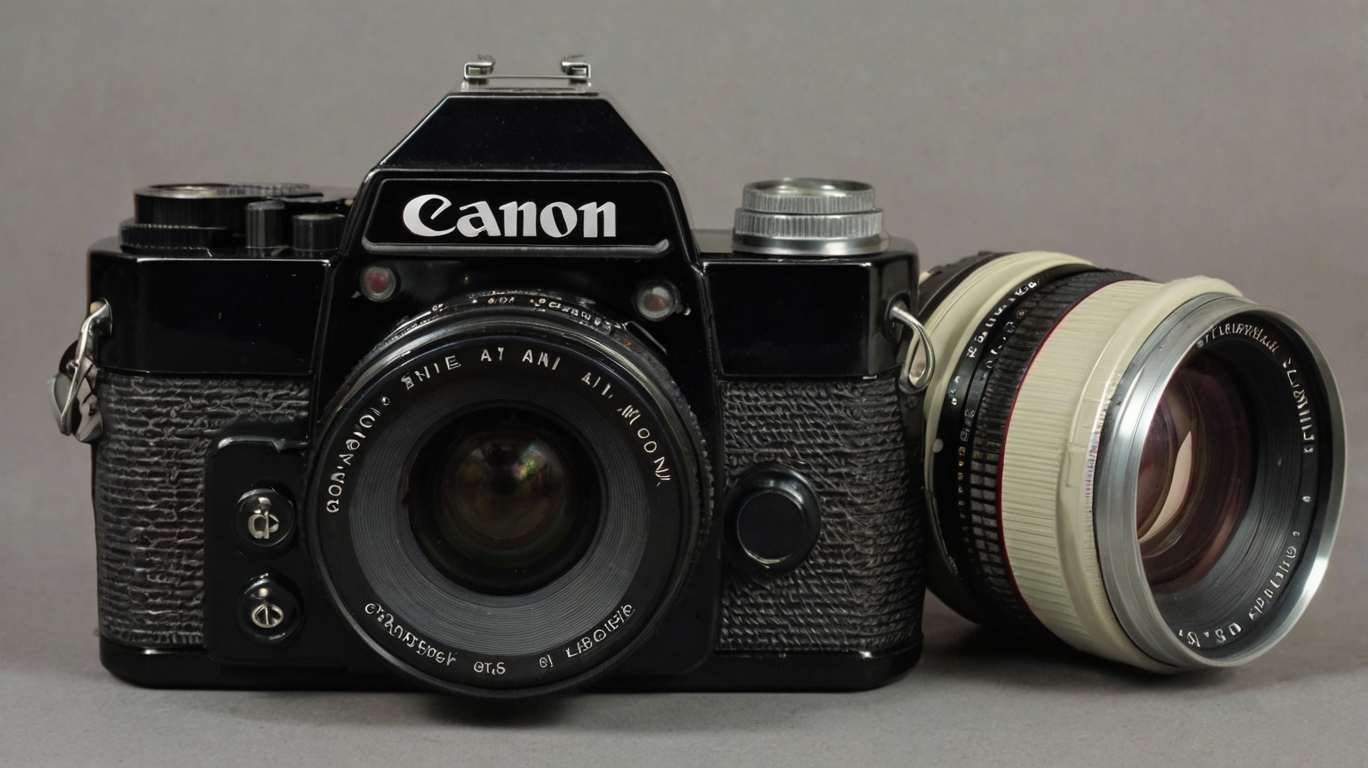The Canon A1 represents a lot beyond a camera. It carries the concept of innovative, precise, and eternal legacy left in the photographic world. Canon A1 was introduced in 1978, which pioneered a model of setting a whole new benchmark model for 35mm single-lens reflex cameras. It was the very first camera with an electronically controlled, programmed auto-exposure system—thus truly the first of its kind in terms of automatic photography. This article is intended to present an overview of the history, features, design, and lasting influence of the Canon A1 in understanding exactly why this camera stands to be one of the most beloved classics by many photographers.

Historical Context
The 1970s Scene in Photography
It was this decade of the 1970s which had seen several revolutionary changes for the world of photography- the demand for SLR cameras had gone out of control due to the sudden interest in both amateur and professional photographic applications. Principal manufacturers in that time included Nikon, Canon, Minolta, and Pentax, each trying to outdo the other in technology and better construction.
In this highly competitive atmosphere, what really helped set Canon apart was innovation and ease of use. A major step in this direction came with the Canon AE-1. It had a microprocessor, which made it one of the first to offer automatic exposure control for both beginners and enthusiasts, hence offering a major selling point. If the phenomenal success of the AE-1 wasn’t seen as a milestone enough, what came ahead was the A-1 in 1978, and it turned out to become the trendsetter for SLRs.
Canon’s Vision
Canon aimed to develop an A-1 camera in which the latest high technologies combine with user-friendliness that even novice to experienced professional image creators will be able to handle. The goal was to be more accessible to many people without having to lose their image quality or to lose control. The A-1 was designed to be flexible in many applications: from fast-paced action to serene landscapes.
Features and Specifications
Electronic Programmed Auto-Exposure
The revolutionary aspect of the Canon A1, though, was its first-of-a-kind electronically controlled, programmed auto-exposure system. This allowed a camera, for the first time, to automatically choose a shutter speed and aperture together, leaving photographers free to worry only about composition and framing while being liberated from technical choices. This made the A-1 remarkably user-friendly, particularly to those new to photography.
Five Automatic Exposure Modes
The Canon A1 was equipped with programmed exposure modes, such as Programmed AE (P), Shutter-Priority AE (Tv), Aperture-Priority AE (Av), Manual (M), and Stopped-down AE, making it flexible for the photographer to select any mode that suited the situation. For instance, Shutter-Priority AE works when fast-moving subjects are going to be captured, while Aperture-Priority AE is best when depth of field needs to be controlled in portrait and landscape photography.
Advanced Metering System
The A-1 had a pretty advanced Center-Weighted Average metering system, meaning it metered exposure by giving greater importance to the middle area of the frame. The system was very dependable in its time and performed exceptionally well under many lighting conditions to ensure the images were well-exposed in most scenarios.
Build and Design
Ergonomics
The Canon A1 had an understanding of ergonomics humanely. Comfortable grip-and-control layout; that camera was easy to handle and manipulate. The button and dial placement was well thought out, so the photographer could reach in and change most of the settings without removing his eye from the viewfinder.
Viewfinder
The viewfinder in the A-1 was bright and clear, with a 93% frame coverage. With the help of the independent split-image rangefinder and microprism collar in the viewfinder, focusing became easy, not to mention very accurate. This was quite handy in bad lighting. The viewfinder would also give needed data, like shutter speed, aperture, and exposure mode, which one would need for reviewing the settings.
A robust metal chassis is among the core components of the Canon A1. This camera was meant to be used on an everyday basis. It was tough, as predicated for better understanding with a solid build and quality materials for long-term service in demanding environments.
Lens Options and Compatibility
One of the real strengths of the Canon A1 was that it would work with the full range of Canon FD lenses. This lens mount system provided an incredible choice of lenses ranging from both ultra-wide-angle to powerfully telephoto, making any kind of photography possible with flexibility and adaptability to any shooting situation.
Innovations and Impact
Pioneering Technology
The programmed auto-exposure system, controlled electronically, was available in the Canon A1. As such, the beginning of photography’s automation age was marched into and has formed a stepping stone in the evolution of future camera technologies. It depicts that automation and professional control may be compatible elements. Available in the A-1, high-quality photography is made significantly near to the reach of many more.
Influence on Future Camera Designs
The Canon A1 became a blockbuster success and went on to entrench the ideas for the design of cameras to come in function and operation. The concepts first presented with the idea of programmed auto-exposure and multimode flexibility would become established as standard in the following cameras, shaping the evolution of film and digital cameras. This predisposition of Canon to innovation brought a standard in the industry that forced other manufacturers to embrace such technologies.
Cultural Impact
Still, beyond the technical feats it achieves, the Canon A1 represents cultural significance in its own right: this was the camera to be used by all levels of photographers, from amateur to professional. Its ease of use and its many innovative features led to it becoming a dear companion in capturing those special moments; hence, it was built to contribute to great personal and historical preservation.
Read More : Best Rated Wireless Earbuds under 3000 (2024)
Using the Canon A1 Today
Collectors and Enthusiasts
Indeed, the Canon A1 is also a keeper for collectors and shutterbugs. It’s in the traditional design that holds lots of history, which is why it’s an acquisition that’s worth a place in one’s collection. Taking pictures using film somehow offers a much different feel for many photographers, and the A-1 can truly become a really good bridge to this classical age of photography.
Practical Use in Modern Digital Photography
Whereas digital photography is now very dominant, the Canon A1 still finds a very practical purpose with many contemporary photographers. At the same time, the growing interest in film photography that has occurred in recent years has led a number of artists and professionals to embrace the peculiarities of its aesthetic and process. Given the fact that it is a dependable camera with quality results, the A-1 happens to be very popular with those who have just come into analog photography.
Tips for Shooting with the Canon A1
- Exposure Modes: Know the various exposure modes to take maximum benefit from the A-1’s potential: Programmed AE for quick shots and manual mode for creative control.
- Regular Maintenance: Given that this camera is quite old, one will need to do regular maintenance on one’s Canon A1 in order to keep it in top working condition. This may include cleaning the lens, checking on the battery, and making sure its film advance mechanism runs smoothly.
- The Numerous FD Lenses: Make use of the many models of Canon FD lenses available. Each one of them possesses traits and creative options of its own, ranging from the sharpness of prime lenses to the flexible nature of zooms.
- Enhancing the Skill of Manual Focusing: Although the A-1 viewfinder helps a lot in focusing, manual focus skills will better your accuracy and thereby the quality of the experience while shooting.
Conclusion :
The Canon A1 is more than a camera; it is a mirror of the innovative spirit and the determination to excel at Canon. It was introduced at a time that would drastically alter how people document their masterpiece of the world through photos. Decades after, it remains the holy grail of photography, a symbol of innovation, indestructibility, and influence on popular culture—always respected and dearly loved by so many all around the world. Whether cherished by collectors, used by enthusiasts, or admired for its historical significance, the Canon A1 remains a timeless icon in the world of photography.
What year was the Canon A1 released?
The Canon A1 was released in 1978.
What type of camera is the Canon A1?
The Canon A1 is a 35mm single-lens reflex (SLR) camera.
What is unique about the Canon A1’s exposure system?
The Canon A1 was the first camera to feature an electronically controlled programmed auto-exposure system.
What exposure modes are available on the Canon A1?
The Canon A1 offers five exposure modes: Programmed AE (P), Shutter-Priority AE (Tv), Aperture-Priority AE (Av), Manual (M), and Stopped-down AE.
What kind of metering system does the Canon A1 use?
The Canon A1 uses a Center-Weighted Average metering system.
Is the Canon A1 compatible with modern lenses?
The Canon A1 is compatible with Canon FD lenses, which are not directly compatible with modern Canon EF or RF lenses without an adapter.
Does the Canon A1 have a built-in flash?
No, the Canon A1 does not have a built-in flash, but it has a hot shoe for attaching an external flash.
What type of battery does the Canon A1 use?
The Canon A1 uses a 6V PX28 or 4LR44 battery.
How do you load film into the Canon A1?
To load film, open the back cover, insert the film cartridge, pull the film leader across to the take-up spool, and advance the film to secure it.
What is the shutter speed range of the Canon A1?
The shutter speed range is from 30 seconds to 1/1000th of a second, plus Bulb mode.
How can I check the battery level on the Canon A1?
The Canon A1 has a battery check button and indicator. Press the button, and if the meter needle moves into the green zone, the battery is good.
What is the viewfinder coverage of the Canon A1?
The viewfinder provides 93% coverage of the frame.
Can the Canon A-1 be used for long exposure photography?
Yes, the Canon A1 has a Bulb mode for long exposures.
Is the Canon A-1 suitable for beginners?
Yes, the Canon A1 is suitable for beginners due to its programmed auto-exposure mode, yet it also offers manual controls for advanced users.
What are some common accessories for the Canon A1?
Common accessories include external flashes, motor drives, different FD lenses, and lens filters.
How durable is the Canon A1?
The Canon A1 is known for its robust metal chassis and high-quality construction, making it quite durable.
What are the dimensions and weight of the Canon A-1?
The Canon A-1 measures approximately 141 x 92 x 48 mm and weighs about 620 grams without a lens.
Can the Canon A-1 shoot in low light conditions?
Yes, with the right film and lens, the Canon A-1 can perform well in low light, especially using manual settings and fast lenses.
What type of film does the Canon A-1 use?
The Canon A-1 uses 35mm film.
Is the Canon A-1 still a good camera to use today?
Absolutely. The Canon A-1 remains a popular choice among film photography enthusiasts for its reliability, versatility, and classic features.




